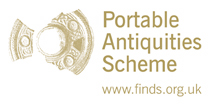File:Early-Medieval, Copper alloy harness fitting (FindID 587262).jpg

Original file (4,724 × 2,289 pixels, file size: 2.39 MB, MIME type: image/jpeg)
Captions
Captions
Summary
[edit]| Early-Medieval: Copper alloy harness fitting | |||
|---|---|---|---|
| Photographer |
Birmingham Museums Trust, Evelyn Curl, 2017-09-26 12:06:50 |
||
| Title |
Early-Medieval: Copper alloy harness fitting |
||
| Description |
English: A complete cast copper alloy strap fitting / double ended strap link (also known as: strap union, bridle link, bridle cheekpiece, rein link or harness link) of later Early Medieval (Anglo-Scandinavian) date (1000-1200). The central element is unusually decorated with a debased relatively crude styled beast - possibly a dragon or wolf. The strap fitting is irregular in plan and broadly D shaped in cross section. The central section contains the beast and from this two horizontal arms / bars project. Each horizontal arm tapers and then expands to form a triangular / lozenge (diamond) shaped strap junction. The arm is a narrow D shape section bar with no evidence of a cast or moulded collars. The strap junction (terminal of the bar) is formed with a cast sub-oval hole through its centre; this has an internal measurement of 12.8mm x 8.2mm. Each of the outer edges of the junction have small wedge shaped projections.
The central boss contains a cast debased zoomorphic design / mask, perhaps a dragon or wolf. The design is broadly symmetrical; being T shaped with ears placed at the ends of the horizontal bar and eyes at the mid point. The design is realised in silver wire fitted within recessed grooves. The snout descends and from the mouth a trefoil shaped tongue extends. This tongue is divided by radial bars of silver wire. From the head of the beast - at the mid point - a rectangular tab with two pierced holes extends. The external edge of the tab is waisted and the the internal diameter of each hole is worn (diameter 3.0mm x 3.6mm). Incised grooves also filled with silver wire loop around the holes in the tab and form a border around its external edge. The rear of the fitting is flat apart from a small oval concave depression (16.8mm x 7.0mm x 5.3mm deep) on the reverse of the central element. The fitting is a mid - brownish green colour with an uneven worn surface patina. The silver wire is a black metallic colour. Movement in the soil has resulted in an asymmetrical appearance in profile - being slightly bowed. A lateral stress fracture can be seen in one of the projecting arms - this is most likely to be from recent movement in the plough soil. David Williams has drawn a number of these examples together in a Finds Research Group datasheet (number 37), which suggests the dating of these is to the early medieval period 1000-1200 and stylistically is part of the Anglo-Scandinavian metalworking tradition. A similar animal mask can be seen on a strap link from Compton Abbas, Dorset (SOMDOR-E14156). Robert Webley has further suggested a parallel with an example from Lund, Skane, Sweden (Pedersen, 1997; 137; fig. 7 and Pedersen 2004, 52-53; fig. 6) which is one of the better archaeologically dated pieces of this type (to c. AD 1020-1050). The overall fitting measures 77.5mm in length, 37.7mm width, is 10.7mm thick (across the central boss), and weighs 41.79 grams. It is likely to date to the period c1050-c1100 and that the form is inspired by Scandinavian design. |
||
| Depicted place | (County of findspot) County of Herefordshire | ||
| Date |
between 1000 and 1150 date QS:P571,+1500-00-00T00:00:00Z/6,P1319,+1000-00-00T00:00:00Z/9,P1326,+1150-00-00T00:00:00Z/9 |
||
| Accession number |
FindID: 587262 Old ref: HESH-B925B6 Filename: HESHB925B6.jpg |
||
| Credit line |
|
||
| Source |
https://finds.org.uk/database/ajax/download/id/631104 Catalog: https://finds.org.uk/database/images/image/id/631104/recordtype/artefacts archive copy at the Wayback Machine Artefact: https://finds.org.uk/database/artefacts/record/id/587262 |
||
| Permission (Reusing this file) |
Attribution License | ||
Licensing
[edit]- You are free:
- to share – to copy, distribute and transmit the work
- to remix – to adapt the work
- Under the following conditions:
- attribution – You must give appropriate credit, provide a link to the license, and indicate if changes were made. You may do so in any reasonable manner, but not in any way that suggests the licensor endorses you or your use.
File history
Click on a date/time to view the file as it appeared at that time.
| Date/Time | Thumbnail | Dimensions | User | Comment | |
|---|---|---|---|---|---|
| current | 18:40, 11 December 2018 |  | 4,724 × 2,289 (2.39 MB) | Fæ (talk | contribs) | Portable Antiquities Scheme, HESH, FindID: 587262, early medieval, page 916, batch count 1064 |
You cannot overwrite this file.
File usage on Commons
The following page uses this file:
Metadata
This file contains additional information such as Exif metadata which may have been added by the digital camera, scanner, or software program used to create or digitize it. If the file has been modified from its original state, some details such as the timestamp may not fully reflect those of the original file. The timestamp is only as accurate as the clock in the camera, and it may be completely wrong.
| Orientation | Normal |
|---|---|
| Horizontal resolution | 300 dpi |
| Vertical resolution | 300 dpi |
| Software used | Adobe Photoshop Elements 7.0 Windows |
| File change date and time | 12:04, 26 September 2017 |
| Color space | sRGB |
| Width | 6,804 px |
| Height | 3,297 px |
| Compression scheme | Uncompressed |
| Pixel composition | RGB |
| Number of components | 3 |
| Image width | 4,724 px |
| Image height | 2,289 px |
| Bits per component |
|
| Date and time of digitizing | 13:04, 26 September 2017 |
| Date metadata was last modified | 13:04, 26 September 2017 |
| IIM version | 47,112 |
